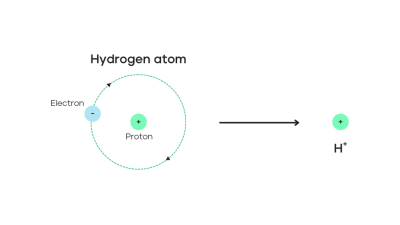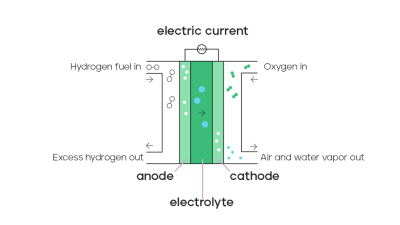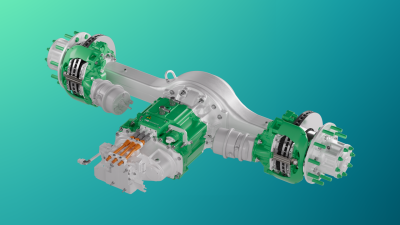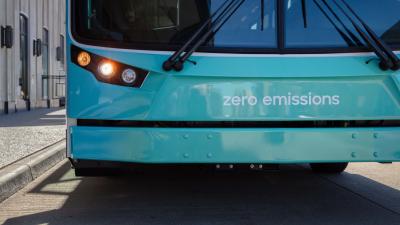Fuel cells in simple terms
Fuel cells are an innovative technology set to revolutionize the way the world generates electricity. Dubbed the “battery of the future,” they are a clean, highly efficient alternative to traditional combustion-based systems like the internal combustion engine (ICE).
What is a fuel cell?
Think of fuel cells as a special type of battery. The end goal of a battery and fuel cell are the same – to generate electricity to provide power to an application. The main difference between the two is where the energy comes from.
Think of batteries like a pre-filled storage container. They already have electricity stored inside, ready to use and don’t require any additional fuel source.
Fuel cells are the opposite. They don’t store electricity – they create it. Fuel cells generate electricity through a chemical reaction, directly converting energy from a fuel source into electrical power. That electricity can then be used to power its applications.
For example, proton exchange membrane (PEM) fuel cells are the current focus for fuel cell vehicles (FCVs). PEM fuel cells use hydrogen fuel to generate electricity. That electricity is fed into a battery, which then powers an electric motor to propel the vehicle into motion.
Parts of a fuel cell
While fuel cells consist of several layers of varied materials, there are three key parts to know:
• Electrolyte membrane
• Catalyst layers (anode and cathode)
• Gas diffusion layers
These three components make up the fuel cell’s membrane electrode assembly (MEA). Sometimes called “the heart” of the cell, the MEA is where electricity, or power, is produced. Regardless of type, a fuel cell will always have an anode, cathode and electrolyte membrane. The difference is what material the electrolyte membrane is made of.
The electrolyte membrane
The membrane separates the two catalyst layers. It acts as the fuel cell’s gatekeeper. Its job is to allow only the necessary positively charged particles to pass through from one catalyst side to the other while blocking the negatively charged particles from crossing over. This component is also where fuel cells get their name. A fuel cell with a polymer electrolyte membrane is called a PEM fuel cell.
The catalyst layers
A fuel cell has two catalyst layers. Each layer consists of an electrode coating of catalyst material. The membrane is sandwiched between them. On one side is a negative electrode (anode), and on the other is a positive electrode (cathode). The anode layer takes in fuel and separates it into protons and electrons. The cathode layer takes in oxygen and converts the oxygen, protons, and electrons to water and heat.
Gas diffusion layers (GDLs)
While the anode and cathode do their parts, the GDLs sit outside the catalyst layers to diffuse gases from the chemical process and remove product water. GDLs help prevent excessive water buildup and help balance between water retention and water release. Water retention is needed to maintain membrane conductivity, and water release is required to keep the pores of the GDLs open so hydrogen and oxygen can diffuse into the electrodes.

How fuel cells generate electricity
A series of chemical reactions occur within the cell to separate electrons from the fuel molecules to generate electricity. In the case of hydrogen, hydrogen gas is fed into the fuel cell on the anode side while oxygen is fed into the cathode. At the anode, hydrogen molecules are separated into protons and electrons. The positive and negative particles then travel two different paths.

The electrons travel to an external electric circuit before continuing to the cathode. The external circuit is where a flow of electricity is created. The positive particles pass through the membrane to the cathode. Once there, the protons reunite with the electrons and react with oxygen to produce water and heat.
Why fuel cells as an alternative to ICE?
The lack of combustion is a huge selling point for investing and adopting fuel cell technologies. While ICE engines and traditional power plants require combustion to convert fuel into energy, a fuel cell does not. It converts the fuel into electricity through a non-combustive electrochemical process. Because there is no combustion, no harmful emissions are associated with the electrical output. The only byproducts are pure water and heat.
Because they can provide clean power for various applications, industries are turning to fuel cells as they look to adopt technologies that will move them toward their emissions targets. Fuel cells are already advancing the commercial transportation industry by powering heavy-duty trucks, buses, rail, and marine vessels. Industries, utility companies, and institutions such as data centers, hospitals and universities also rely on fuel cells. These stationary applications include backup power, peak shaving, and portable and auxiliary power generation.
With the climate crisis at the top of everyone’s mind, industries are eager to shift to more environmentally friendly power solutions. Fuel cells are one very promising solution, but there’s a reason they’re called the “battery of the future.” Advancements have been made in the past 20 years, and more advances are needed before fuel cell-powered semis are driving across every highway. But at Accelera™ by Cummins, we’re confident we’ll get there. We are actively investing in PEM fuel cells for commercial vehicle transportation and stationary power, believing they are a vital solution that will accelerate the shift to zero emissions.
After all, fuel cells helped send the first humans to the moon in 1969. So, if NASA can do it, why can’t we?
Want to see real-world examples of fuel cells in action? Check out these demonstration projects:

